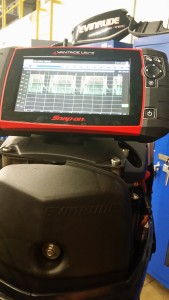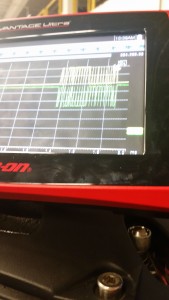This is what DC electricity looks like using an oscilloscope. What you are looking at in this photo above is an Evinrude E-Tec 50 HP outboard engine connected to digital gauges through a NMEA 2000 backbone connection. The photo above is what corrupted digital data looks like.
How this system works is fairly simple. The system runs off a high / low voltage system (low is 1.5 – 2.5 volts and high is 2.5 – 3.5 volts). The two voltages on the high / low mirror each other to confirm accurate data to the ECM. The resistance is 60 ohms in the NMEA 2000 backbone system. When a “T” connector, wire connection, terminator or gauge malfunctions, the data becomes corrupted and this clear high / low data can not communicate clearly. This is what causes digital gauges to not work properly, freeze, etc. Connecting the oscilloscope to the NMEA 2000 backbone allows you to see this data while you trouble shoot the system. Mirrored wavy lines is clean data. Lines that run into each other, in consistent high / low digital data (not alike on the high and low sides), and spikes in the data show that there is corrupted data. By isolating and disconnecting each “T” connector (if there are multiple backbones on board) one by one until the oscilloscope shows clean data is how you find the problem.
The data is so fast it runs on a factor of milliseconds and can not be detected using a multi-meter (only good for verifying resistance). Using an oscilloscope is the only way to confirm clean data. This system also works on CAN bus systems such as in the Mercury outboard / inboard engines.
I thought this would be helpful to anyone that may encounter this problem on their boats and what to expect and look for in the diagnosis and repair.


